| Article ID | Journal | Published Year | Pages | File Type |
|---|---|---|---|---|
| 869950 | Biosensors and Bioelectronics | 2006 | 7 Pages |
The suitability of high resolution, in situ dc-sheet resistance monitoring (SRM) as a simplified and reliable sensing technique towards detection and tracking of protein immobilization has been explored. Non-specific adsorption of bovine serum albumin (BSA) onto a very thin gold film, acting as the sensing resistor, has been employed as a model system. For comparison, the novel sensing method was combined with surface plasmon resonance (SPR) spectroscopy, using the same flow cell and sensing surface. Two different, well known adsorption states, involving a composite layer of irreversibly and reversibly bound BSA, were clearly resolved by both methods. Clearly structured, pronounced and fully reproducible film resistance modulations have been resolved in the associated SRM data. The transition from reversibly bound BSA to the diluted protein phase is associated with an unusually large decrease in the dc-sheet resistance. The observed resistance modulation magnitude for an adsorbed BSA monolayer corresponds to approximately 1%, and up to 100 mΩ at a 10 Ω sensing resistor. The sheet resistance of irreversibly bound BSA was determined to 0.24 kΩ/cm2, and the associated specific resistivity estimated to 1–2 × 104 Ω cm.
